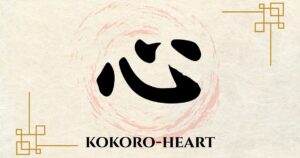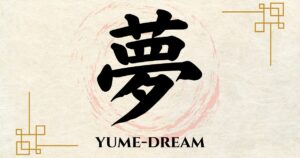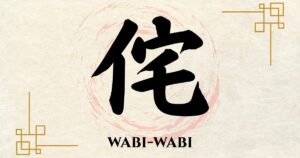It’s not just about romance.
When people see the kanji character “愛 (Ai)”, they often think it simply means “love,” perhaps in a romantic sense.
But the story of Ai goes much deeper.
Its origins lie in the image of the human heart, and its many readings reveal a vast spectrum of emotion, from joyful adoration to a beautiful, heart-aching tenderness.
Over time, this single character grew to embody not only romance, but also compassion, cherishable affection, and the profound, sometimes painful, connections that bind us together.
The Origins of the Character
The kanji 愛 is a complex character with a rich history. The most crucial component is at its center:
- 心 (kokoro) — meaning “heart”
The character’s ancient form depicts a heart (心) along with other elements that suggest a person looking back or hesitating (夊), as if overcome with powerful emotion.
The overall image suggests a feeling so profound that it originates in the heart and affects one’s entire being.
This etymology perfectly supports the complex emotions found in its many readings.
How to Read “愛” (Ai)
The true depth of this character is revealed in its many readings, each carrying a unique shade of meaning.
On-yomi (Sino-Japanese reading)
- ai (アイ) — This is the most common reading, used in countless compound words that form the foundation of love in society, such as
aijō(愛情, affection) andren'ai(恋愛, romantic love).
Kun-yomi (native Japanese readings)
The native readings uncover the emotional core of the character.
Common Readings:
- itoshii (いとしい) — Beloved; dear; precious. A direct and powerful expression of fondness.
- mederu (めでる) — To love; to admire; to cherish. This is an active verb, often used for things one treasures, like a child, a pet, or the beauty of nature.
Nuanced & Poetic Readings: These rarer readings show the full, complex scope of “love.”
- kanashii (かなしい) — While usually meaning “sad,” this reading reveals the link between deep love and sorrow. It signifies a love so profound it’s almost painful, a beautiful ache in the heart.
- oshimu (おしむ) — To cherish something so dearly that you regret its passing or loss. This reading connects love with value and the preciousness of the moment.
- ui (うい) — An archaic and poetic reading for something fragile, innocent, and endearingly precious. It expresses a tender affection for something vulnerable.
- mana (まな) — A special reading often used in names (e.g., Manami, 愛美) or to refer to a beloved person, like a favorite student (
manadeshi, 愛弟子).
“Ai” in Japanese Culture
Over the centuries, 愛 (Ai) grew to symbolize much more than romance.
It became a cultural keyword for the deep, heartfelt bonds in all aspects of life.
n familiar words like:
- 愛情 (aijō) — The deep, nurturing affection between family and friends.
- 博愛 (hakuai) — Universal love or philanthropy; compassion for all humanity.
- 愛用 (aiyō) — To use a favorite item with care and affection.
…we see the common ai reading.
But within these concepts, we can feel the echoes of the character’s deeper meanings—the cherishing (mederu), the preciousness (itoshii), and the profound, heartfelt connection (kanashii).
Closing
When you bring the kanji 愛 (Ai) into your home, you are welcoming more than just “love.”
You are inviting the entire spectrum of deep human emotion: the joy of cherishing, the tenderness of affection, the bittersweet ache of a powerful bond, and the spirit of connection in its most profound and beautiful forms.






コメント